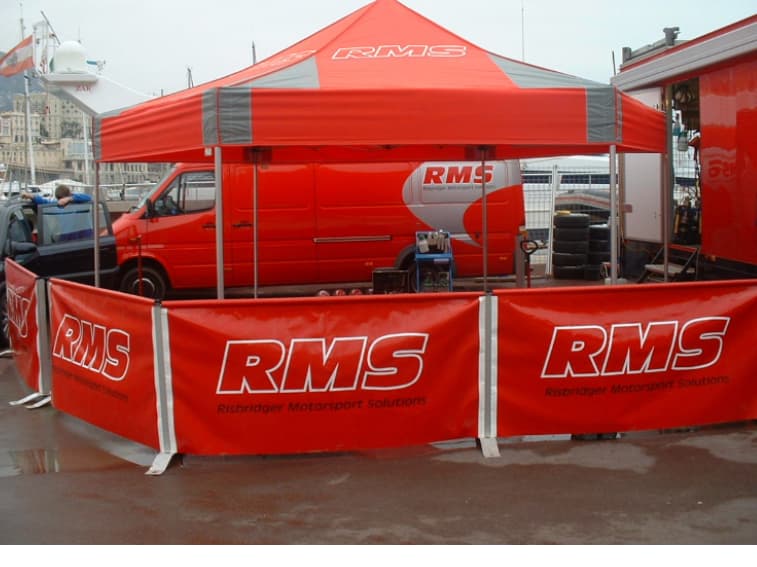Best practices with safeguard barriers for large-scale motorsport events
Safety is obviously absolutely critical for any large-scale motorsport event, which is a big reason why one of the most important elements is the effective use of safeguard barriers. These sturdy barriers serve a variety of key roles, and have been designed to protect drivers in the event of a crash, keep spectators safe from errant cars, and ensure that staff can work without being exposed to unnecessary risks.
What’s more though, they also have a range of useful secondary applications too. For example, properly installed barriers can also help manage crowd flow, prevent unauthorised access, and support emergency services when required.
We have decades of experience serving the motorsport industry here at the Awning Company, primarily through our market-leading commercial awnings. Safeguard barriers are another key part of our offering though, so you can trust us to know the best practices as to their usage. Here’s what we’d advise.
Barrier placement for maximum safety
Barriers always need to be strategically positioned around the racetrack to ensure maximum protection, particularly in high-risk zones. The barriers will need to be positioned in a way that offers the best protection for both drivers and spectators, while still maintaining line of sight to the track. Tight corners, chicanes, and high-speed sections of the track are all some of the key areas where barriers will need to be prioritised. They’ll also need to be installed around spectator zones, with a specific focus on ensuring that the crowd is kept a safe distance from the track.
And of course, visibility must be taken into account when placing barriers, as drivers need clear sightlines to navigate the track safely. It’s also important to consider accessibility for emergency responders. Barriers cannot obstruct access routes, as there should be clear pathways for medical teams and safety cars to reach the scene quickly if an incident occurs.
Crowd flow and restricted areas
Managing crowd flow is a critical aspect of any large-scale event, and motorsports are no exception. Barriers are key to controlling the movement of spectators, ensuring that they are confined to designated viewing areas and preventing them from entering restricted zones. As well as maintaining safety, this also helps avoid crowd congestion, which itself can lead to accidents (crowd crushes are not unheard of). Equally importantly, they can potentially hinder emergency responses.
In addition to guiding spectators, safeguard barriers can be used to clearly define areas that are off-limits to the general public, such as the pit area, trackside sections, and staff-only zones. Restricting access to these high-risk areas prevents anyone without proper authorisation from wandering into dangerous zones, where they might inadvertently come into contact with the track or other hazards. Emergency escape routes also need to be clearly marked and kept clear of barriers to allow for swift evacuations if necessary.
Track conditions and risk zones
Barrier placement needs to be flexible to a point, allowing for adjustments based on track conditions, layout, and weather forecasts. For instance, areas where drivers are most likely to crash should have more substantial barriers in place (for example, sharp corners or places where the track is prone to puddling or poor grip). These zones are considered high-risk and require the installation of barriers that can withstand significant impact without failing.
Barriers around run-off areas are particularly important, as they can help slow down or stop a car that has lost control. The type of barrier used may vary depending on the risk level of each zone. For example, higher-risk areas may benefit from reinforced barriers, while less hazardous sections may be sufficiently protected with lighter, flexible barriers. It’s also essential to account for weather conditions such as rain or wind, which can affect the track’s surface and the performance of barriers, necessitating extra precautions.
Inspections and maintenance checks
After installation, regular inspections and checks are equally critical. Barriers need to be regularly inspected to ensure they are functioning effectively throughout the event. Prior to the event, a thorough inspection will need to take place, verifying that all barriers are correctly installed and secure. During the event, safety teams need to perform ongoing checks to ensure that the barriers have not been damaged by accidents or weather conditions. After each race or session, the barriers should be assessed again to ensure they remain in proper working order.
In addition to visual inspections, it’s also a good idea to regularly conduct more in-depth tests, especially on barriers designed to absorb impact, such as those used in high-risk corners or run-off zones. Any damaged or compromised sections should be immediately replaced. This ensures that the barriers continue to provide the protection they were designed for, maintaining the safety of all involved.
This is just a quick rundown of the essentials – if you have any specific questions about the specifications or usage of our safeguard barriers or commercial awnings, don’t hesitate to ask our team here at the Awning Company. We have decades of experience in the sector, and we’re the go-to choice for local, national and international teams, as well as race organisations. You can give us a call on 01204 544 900, and we’ll be happy to help in any way we can!


 Menu
Menu Close
Close
 Made to measure
Made to measure
 Made in Britain
Made in Britain
 Free design service
Free design service
 UK's #1 Awning Company
UK's #1 Awning Company
